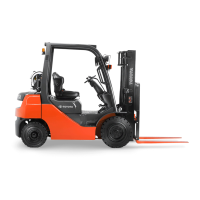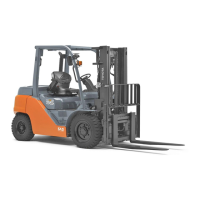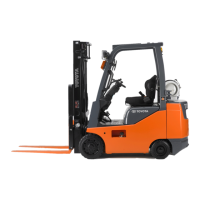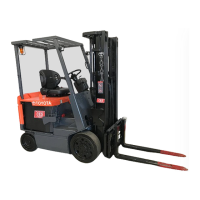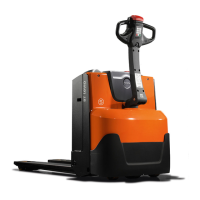
Do you have a question about the Toyota BT Levio W Series and is the answer not in the manual?
| Model | BT Levio W Series |
|---|---|
| Battery Type | Lead-acid or Lithium-ion |
| Battery Voltage | 24 V |
| Application | Warehouse, Logistics, Manufacturing |
| Drive | Electric |
General overview of the specific truck series.
Details of the LWE140 model, features and applications.
Details of the LWE160 model, features and applications.
Details of the LWE180 model, features and applications.
Details of the LWE200 model, features and applications.
Details of the LWE250 model, features and applications.
Describes walkie operation applications and environments.
Describes applications for stand-on platform versions.
Applications in industrial settings, reliability needs.
Applications in warehouses and distribution hubs, high productivity.
Applications in retail environments, ease of use and safety.
Factors determining the suitable truck model for specific tasks.
Focuses on ease of use and operator friendliness.
Features enhancing truck maneuverability.
Operator visibility and design aspects.
Details on truck controls and operation.
Highlights features contributing to operator and truck safety.
Features protecting the operator during use.
Programmable settings for different users and applications.
Discusses features that ensure long service life and reliability.
Features designed to minimize downtime and maximize availability.
Aspects of the truck design that facilitate maintenance.
Describes the operator's workspace and comfort features.
Details the design and function of the tiller arm and its integrated controls.
Explains the different methods for starting the truck.
Describes the tiller arm's design, optimization, and steering angle.
Details the location and function of the emergency stop button.
Explains the truck's display panel and its indicators.
Describes available battery cover types and storage options.
Overview of truck driving characteristics and user programmability.
How system parameters are saved and restored.
Instructions and list of parameters adjustable by the operator.
How to view machine-specific settings and service data.
Configurable automatic shutdown feature.
Functionality for slow-speed maneuvering.
Details on the truck's braking systems and operation.
Information on the drive motors and pump motors used.
Specifications of the motor controllers used in the trucks.
Details on the AC drive motors, their size, and benefits.
Explanation of the integrated drive system.
Overview of drive wheel specifications and material options.
Detailed comparison of available drive wheel materials.
Details on the mounting and configuration of the drive wheel.
Information on connectors, wiring, and environmental protection.
Details on the truck's cover material, design, and ease of access.
Information on chassis width, reinforcement, and design.
Information on castor wheel width and material options.
Explanation of the castor link system for stability and load handling.
Description of narrow, standard, and reinforced fork carriages.
Details on axle and bushing materials and design.
Information on fork wheel designs (single vs. bogie).
Considerations for selecting batteries and chargers.
Comparison of freely ventilated and valve-regulated batteries.
Procedures for connecting and charging the battery.
Types of chargers and selection criteria.
Outlines key measurements and performance data for the truck.
Defines the distance from back of fork to fork wheel centre.
Defines the total fork length.
Defines the truck length including the back of the fork.
Defines the distance from fork tip to wheel-fork pivot point.
Defines the distance from back of forks to wheel fork pivot point.
Defines distance from fork tip to front face of fork wheel.
Tables detailing fork lengths and associated measurements.
Definitions and values for fork width and dimensions.
Defines turning radius and its importance for maneuverability.
Formula and explanation for calculating required aisle width.
Tables showing aisle width requirements for different models and pallet types.
Details dimensions and specifications of Euro and Chep pallets.
Guidance on selecting fork specifications based on load carriers.
Tables indicating fork suitability for various pallet types and lengths.
Tables showing battery weights and compartment sizes for each model.
Information on Hawker Evolution GEL batteries and charging.
Charger recommendation table for freely ventilated batteries.
Details an option for easier lateral battery replacement.
Describes an external table to facilitate battery changes.
Optional cables for multiple batteries.
Cable for connecting truck to battery change table.
Details the integrated charger's features and benefits.
Accessory for optimizing long side pallet handling.
Fleet management and data logging systems.
Overview of the fleet management system.
Details of the wireless data collection system.
Monitors collisions and driver behavior.
System for mounting electronic equipment on the truck.
Feature for temporary speed reduction.
Option for stand-on operation, with features and benefits.
Optional attachment for added support of loads.
Details on the robust metal battery cover option.
Option for improved handling on gradients and thresholds.
Special oil for operation in cold environments.
Option for wet/humid environments.
Information on the company's environmental policies and practices.
Outlines Toyota's quality principles and systems.
Displays ISO certifications for the company.





